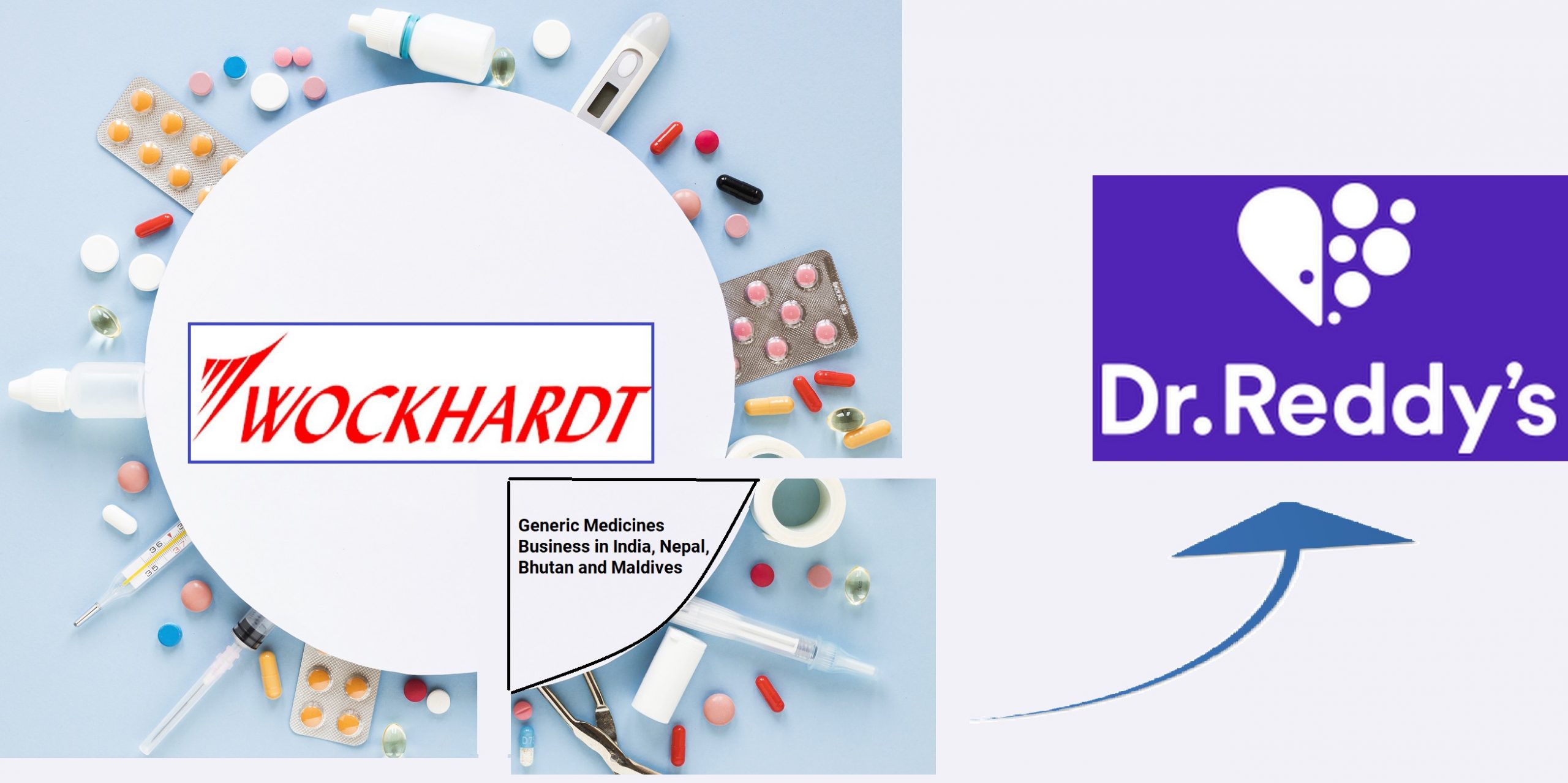Hyderabad-based pharma major Dr Reddy’s Laboratories will buy Wockhardt Ltd’s branded generics business in India, Nepal, Sri Lanka, Bhutan and Maldives and its manufacturing plant at Baddi in Himachal Pradesh for around Rs 1,850 crore. Wockhardt is selling a part of the business because of its plans to ensure adequate liquidity. Dr Reddy’s is paying more than three times of the revenues that Wockhardt’s acquired business is generating.
In the due course, Wockhardt’s strategic plan is to shift from acute therapeutic areas to more chronic businesses like anti-diabetes, central nervous system and also into niche antibiotic portfolios. The sell-off will fetch Wockhardt adequate liquidity for investing in growing business both in India and abroad.
The Wockhardt’s business, which is changing hands, is pegged around revenue of Rs 370 crore in the current financial year (2019-20) till December and around Rs 600 crore in 2018-19. In fact, in 2018-19, the divested portfolio constituted 28% of standalone revenue and 14% of the consolidated revenue.
Deal
The deal agreement comprises of portfolio of 62 brands in multiple therapy areas such as respiratory, neurology, dermatology, etc. Once the deal is done, Wockhardt will continue to run international operations in the United Kingdom, the United States, Ireland and in other countries through its step-down subsidiaries. The deal is likely to be finalised by the second quarter of next financial year.
The deal will definitely boost Dr Reddy’s presence in high-growth therapy areas with brands such as Practin, Zedex, Bro-zedex, etc. Wockhardt will also transfer to Dr Reddy’s sales and marketing teams related to these areas. The transaction is likely to be largely funded through internal accruals, except for some short-term funding to handle timing mismatch.
| Year | Wockhardt Ltd | Dr Reddy’s Laboratories | |||
| Income | Net profit | Revenue | Net profit | ||
| 2016-17 | 2546 | 137 | 14080 | 1203 | |
| 2017-18 | 2534 | 69 | 14202 | 980 | |
| 2018-19 | 2181 | -82 | 15385 | 1879 | |
| 2019-20 (Till December) | 1136 | -153 | 13028 | 1185 | |
Edge for Dr Reddy’s Laboratories
The deal surely signifies Dr Reddy’s de-risking strategy with regards to its business in the United States, which has taken a hit because of regulatory actions. As a part of the company’s diversification policy, Dr Reddy’s Laboratories is gradually moving capital allocation towards emerging markets and the deal is definitely consistent with that thinking. Over the last few years, Dr Reddy’s has focused on growing its business in the Indian market and rise up the pecking order and be in the top-10 slot in the near future. At present, with 2.4% market share, Dr Reddy’s Laboratories rank number 14 in India in terms of market share.
In the past, Dr Reddy’s Laboratories had expanded its export business, especially in the distributor-led markets like the United States and Europe. The company had invested heavily in these markets even as entry barriers remain very high for companies from Asia because of stringent safety and regulatory norms. However, Dr Reddy’s Laboratories got a foothold in these markets and even got good returns. Their focus on export market meant that the company did not focus much on the domestic market, especially in the branded generic segment.
However, regulations for non-American pharma companies are fast changing in the United States. There is even pricing pressure in the US market because of consolidation in trade channels. As a result of these uncertainties, Dr Reddy’s Laboratories is now shifting its focus from the exports market to the domestic branded formulation market.
But the challenges in the Indian market are even much more than foreign markets. For instance, in the branded generic market many companies push their products through various channels. Given the fact that the government puts in price control and drugs are price sensitive even for consumers, it is indeed challenging to get a foothold in the Indian generic market and maintain margins.
In the domestic market, Dr Reddy’s Laboratories could not gain the edge that its peers such as Sun Pharma, Cipla, Lupin, Torrent have. These companies have more than a fourth of their revenues from the Indian market. In contrast, Dr Reddy’s Laboratories gets only 17% of its sales from the domestic market. In 2018-19, domestic formulation business for Dr Reddy’s Laboratories accounted for Rs 2,620 crore of the total revenue of Rs 15,385 crore.
The acquisition of Wockhardt Ltd’s branded generics business will help Dr Reddy’s Laboratories to gain access to the domestic market as Wockhardt has a good track record. After the acquisition is completed, the domestic market is likely to contribute around 20% of Dr Reddy’s Laboratories revenues and even jump two places to 12 in the pecking order by market share.
About Wockhardt
The company was founded by Dr Khorakiwala in 1960 as Worli Chemical Works. Gradually, it becomes one of the top five domestic drug firms after few acquisitions in Europe and the US. It acquired UK-based Wallis Laboratory in 1997, CP Pharmaceuticals in 2003, Germany-based Espharma in 2004, Pinewood Healthcare in Ireland in 2006, Negma Laboratories in France and Morton Grove in the US in 2007. But with these acquisitions, the debt level started rising. Also, during the global financial crises of 2008, it suffered massive foreign exchange derivative look and was put into a corporate debt restructuring (CDR) by lenders. To recover and pay off debt, Wockhardt had to sell off many of its assets such as the nutrition business for Rs 1,280 crore to French dairy giant Danone, Animal Healthcare business to French company Vetoquino, and 10 of the 17 hospitals to Fortis for Rs 919 crore.
After aggressive foray into the US market and strong focus in the domestic market, the company recovered its business. It turned profitable and increased business. However, in the US, seven plants got into the US regulator’s (USFDA) scanners because of manufacturing quality issues. The company’s standalone total income had gone down from Rs 2,534 crore in 2017-18 to Rs 2,181 crore in 2018-19. It posted a net loss of Rs 82 crore in 2018-19 against a profit of Rs 69 crore a year ago.
Gain for Wockhardt
With the money from the sale off, Wockhardt can invest in its international operations, especially in Biosimilars for the US market apart from the company’s global clinical trials of Break-through Anti-Infectives and R&D initiatives. Moreover, Wockhardt’s EBITDA margin is subdued and the company’s balance sheet is much leveraged as the company has a debt of Rs 2,100 crore as on December 31, 2019.
At present, Wockhardt has a diversified product portfolio with a strong presence in major therapeutic segments such as cardiology, dermatology, diabetes, respiratory and ophthalmology. In January this year, the company announced that the Drug Controller General of India has approved its two new antibiotics, EMROK (IV) and EMROK O (Oral), for acute bacterial skin and skin structure infections including diabetic foot infections and concurrent bacteremia. The two new antibiotics have been developed after researching for over 20 years.
The promoters of the company had been trying to raise money through various ways to repay its piling debt. Last year, the company had hired bankers to raise dollar bonds worth $300 million, which didn’t materialise. In fiscal 2018-19, the promoters had infused Rs 250 crore in the form of redeemable preference shares to refinance the outstanding preference debt. As the debt level of the Wockhardt is piling, shareholders can expect more dilution going forward if the company has to clean up its balance sheet quickly.
Conclusion
Once the deal is complete, it will be a win-win situation for both the companies. Dr Reddy’s Laboratories will be able to expand its footprint in the domestic market. For Wockhardt, the deal will help to get liquidity to pare debt and the company and it will be easier for the company in the areas ere they want to expand.





Add comment